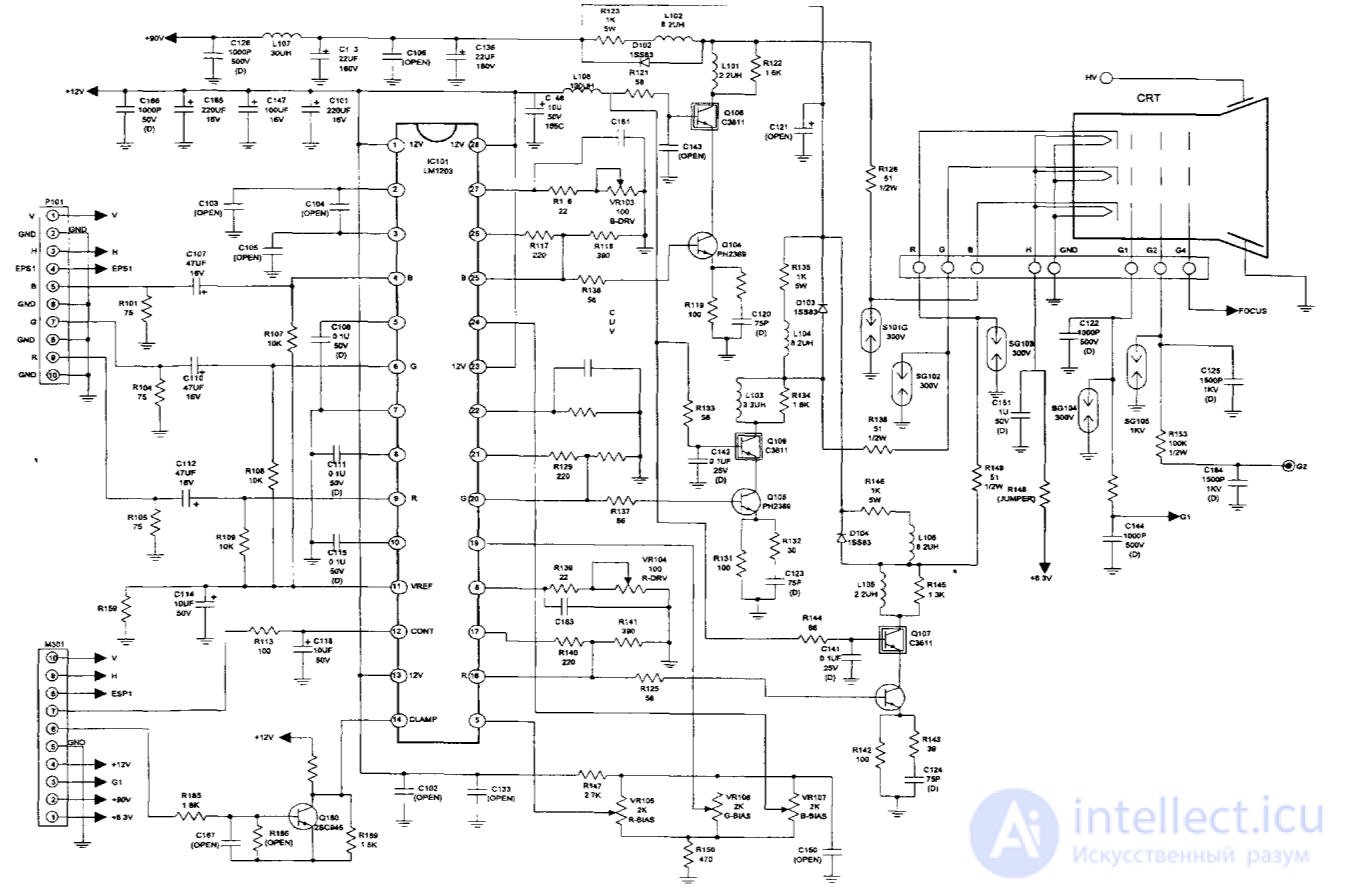Lecture
Input devices provide a connection between the VM and the computer and the passage of video signals to the final video amplifiers.
The main requirements that must be met by the input circuits and video signal processing nodes are: transfer of video signals and synchronization signals from a computer to VM nodes without distortion, as well as their stability over time, so that the image on the screen has maximum clarity, raster stability and retains its brightness parameters . These requirements must be consistent with the VM class, its modes of operation, and the limit parameters of a CRT.

Figure 59 - Typical input device and video amplifiers
The type and characteristics of the signals input to the monitor are presented in the table.
|
No |
Signal |
Signal type |
|
|
payment order |
|
||
|
|
|
|
|
|
one |
R video |
analog |
|
|
2 |
G video |
analog |
|
|
3 |
Video B |
analog |
|
|
four |
ID |
TTL |
|
|
five |
0B |
0V |
|
|
6 |
Screen r |
0V |
|
|
7 |
Screen g |
0V |
|
|
eight |
Screen B |
0V |
|
|
9 |
Key (contact missing) |
|
|
|
ten |
SYNC screen |
0V |
|
|
eleven |
ID |
TTL |
|
|
|
0 |
|
|
|
12 |
ID |
TTL |
|
|
|
one |
|
|
|
13 |
HSYNC (horizontal sync signal) |
TTL |
|
|
14 |
VSYNC (sync frame frame) |
TTL |
|
|
15 |
Not used |
|
|
Inspection and repair of the video signal processing unit
Troubleshooting in the video signal processing node is performed after the power supply and scan nodes have been restored, so that the screen can be lit, i.e. so that all voltages on a CRT are close to the workers. The first inclusion for checks can be made without connecting a signal from the computer. Turn the knobs for setting the brightness and contrast on the front panel to the maximum position and turn on the power of the VM. In the absence of a luminous raster on the screen, check for the presence of all necessary voltages on the CRT, including the high voltage at the anode, and the glow of red from the filament in the area of the base. If it is absent, remove the CRT socket and measure the resistance of the filament directly on the leads with an ohmmeter - it should be less than 3 ohms. A break in this circuit or a large resistance indicates a defect and the need to replace a CRT. If there is heat and all voltages are normal, you should try changing the position of the G1 setting (usually the lower knob, SCREEN) on the TDX to achieve a moderate raster glow and then check the effect of the focus setting (upper FOKUS knob), evaluating the result from the raster edges sharpness or observing individual lines . In the course of these checks, possible malfunctions of a CRT are identified, they may be: internal breakages of the leads from the electrodes and short circuits between them.
At the next stage, the VM is connected to a computer and the operation of the video signal processing unit is checked using a text image or graphic tests. In this case, additional malfunctions can be revealed both in the CRT and in other nodes, however, defects are more often manifested in electronic circuits than in the CRT itself.
Typical symptoms of a video signal processing node are:
The above faults can be called global, that is, until they are eliminated, it is impossible to evaluate the operation of the node as a whole. After overcoming global faults, you can fully use all the adjustments to obtain an image sufficient to assess its quality. Image quality control is performed by the pictures obtained when running test programs. In the case of testing video nodes, the program in the computer must provide test images for the following checks and adjustments:
When checking for test images, the following malfunctions can be detected:
After obtaining a stable image in one of the main operating modes of the VM, repeat the verification of the characteristics of the tests, both of this mode, and of all possible others for this VM.
Comments
To leave a comment
Diagnostics, maintenance and repair of electronic and radio equipment
Terms: Diagnostics, maintenance and repair of electronic and radio equipment